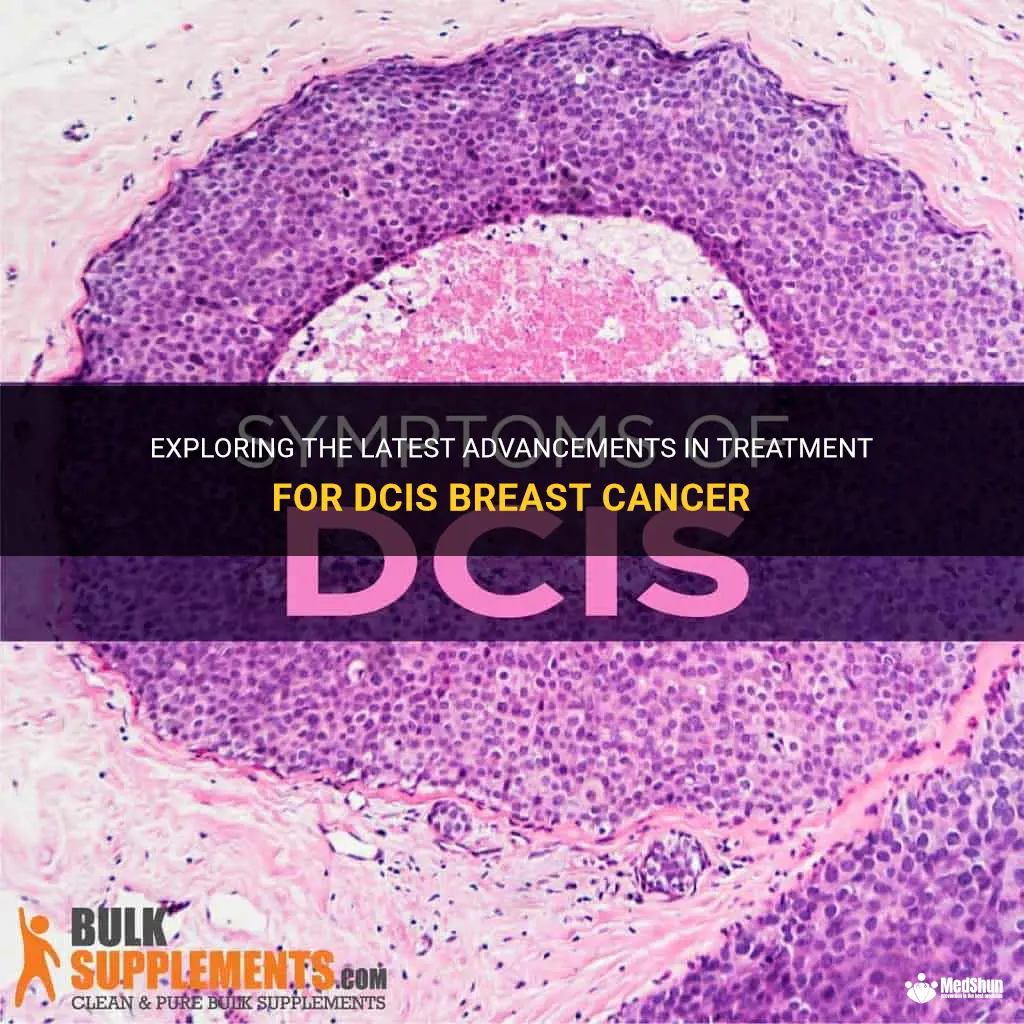
Breast cancer is a devastating disease that affects millions of women worldwide. One form of breast cancer, called ductal carcinoma in situ (DCIS), is a non-invasive condition that starts in the milk ducts and has the potential to become invasive if left untreated. Fortunately, there are various treatment options available for women diagnosed with DCIS, ranging from surgery to radiation therapy. In this article, we will explore the different treatment approaches for DCIS and the factors that may influence the choice of treatment.
| Characteristics | Values |
|---|---|
| Treatment | Surgery, radiation therapy, hormonal therapy, targeted therapy |
| Surgery | Lumpectomy, mastectomy |
| Radiation Therapy | External beam radiation, brachytherapy |
| Hormonal Therapy | Tamoxifen, aromatase inhibitors |
| Targeted Therapy | Trastuzumab, Pertuzumab |
What You'll Learn
- What are the different treatment options available for DCIS breast cancer?
- How do doctors determine the best treatment approach for DCIS breast cancer?
- What are the potential side effects and risks associated with various treatments for DCIS breast cancer?
- Are there any alternative or complementary treatments that can be used alongside traditional treatment options?
- What are the long-term outcomes and prognosis for individuals with DCIS breast cancer who undergo treatment?

What are the different treatment options available for DCIS breast cancer?
Ductal carcinoma in situ (DCIS) is a common form of breast cancer that begins in the milk ducts and has not yet spread to the surrounding tissue. DCIS is considered to be non-invasive, meaning it has not yet developed the ability to spread to other parts of the body. However, if left untreated, it can progress to invasive breast cancer.
There are several treatment options available for DCIS breast cancer, and the choice of treatment depends on various factors such as the size and grade of the tumor, the patient's overall health, and personal preferences. The main treatment options for DCIS breast cancer are as follows:
Surgery: Surgery is the most common treatment for DCIS breast cancer. The goal of surgery is to remove the cancerous cells while preserving the breast. The two main surgical options for DCIS are lumpectomy and mastectomy.
- Lumpectomy: Also known as breast-conserving surgery, a lumpectomy involves removing the tumor along with a small margin of normal tissue. This procedure is usually followed by radiation therapy to reduce the risk of recurrence.
- Mastectomy: In a mastectomy, the entire breast tissue is removed, including the nipple. Depending on the size and location of the tumor, a mastectomy may be recommended to ensure complete removal of the cancer.
- Radiation therapy: After a lumpectomy, radiation therapy is often recommended to destroy any remaining cancer cells in the breast. Radiation therapy involves the use of high-energy X-rays or other types of radiation to kill the cancer cells. It is usually administered daily over a period of several weeks.
- Hormone therapy: Hormone therapy is recommended for certain types of DCIS breast cancer that are hormone receptor-positive. This means that the cancer cells have receptors for estrogen or progesterone hormones, which stimulate their growth. Hormone therapy involves the use of medications that block or reduce the effects of these hormones. It may be administered before or after surgery to reduce the risk of recurrence.
- Chemotherapy: Chemotherapy is not typically used as a primary treatment for DCIS breast cancer since it is considered non-invasive. However, in some cases where the cancer is aggressive or has a high risk of recurrence, chemotherapy may be recommended.
- Clinical trials: In certain cases, patients may be offered the opportunity to participate in clinical trials for new treatment approaches. Clinical trials are crucial for advancing research and developing new treatment options for cancer patients.
It is important for patients diagnosed with DCIS breast cancer to discuss their treatment options with a multidisciplinary team of healthcare professionals, including surgeons, radiation oncologists, medical oncologists, and pathologists. The team will consider various factors and individualize the treatment plan based on the patient's specific needs and circumstances. It is also important for patients to ask questions, seek second opinions, and take an active role in their treatment decisions.
In conclusion, there are several treatment options available for DCIS breast cancer, including surgery, radiation therapy, hormone therapy, chemotherapy, and participation in clinical trials. The choice of treatment depends on individual factors and should be discussed with a healthcare team to determine the most appropriate and effective treatment plan.
New Advances in Treatment for Positive Sentinel Node Breast Cancer
You may want to see also

How do doctors determine the best treatment approach for DCIS breast cancer?
Doctors determine the best treatment approach for ductal carcinoma in situ (DCIS) breast cancer by considering various factors, such as the size and location of the tumor, the presence of any high-risk features, and the patient's overall health and personal preferences. DCIS is a non-invasive form of breast cancer where abnormal cells are found in the lining of the milk ducts but have not spread to other tissues. It is referred to as stage 0 or pre-invasive breast cancer.
To determine the best treatment approach for DCIS breast cancer, doctors typically follow a step-by-step process that involves diagnosing the condition, assessing its characteristics, and considering various treatment options.
- Diagnosing DCIS: The first step in determining the treatment approach is an accurate diagnosis. This usually involves a mammogram, which can detect the presence of suspicious calcifications or masses in the breast tissue. If a suspicious area is found, a biopsy is performed to confirm the diagnosis of DCIS.
- Assessing tumor characteristics: Once DCIS is diagnosed, doctors further evaluate the tumor's size, grade, and extent of involvement. The size of the tumor is measured to determine if it is small (less than 1 cm) or large (greater than 5 cm). The tumor grade indicates how abnormal the cells appear under a microscope, with higher grades indicating a higher risk of recurrence. The extent of involvement determines how much of the ductal system is affected by DCIS.
- Considering risk factors: Doctors also take into account any high-risk features that may influence the choice of treatment. These features include the presence of necrosis (death of tumor cells) within the DCIS, high-grade tumors, positive margins (when tumor cells are found at the edge of the removed tissue), or the presence of genetic mutations such as BRCA1 or BRCA2.
- Treatment options: Once the tumor characteristics and risk factors are assessed, doctors can determine the most appropriate treatment approach for DCIS breast cancer. The available options include:
A. Surgery: Surgery is the primary treatment for DCIS and aims to remove the abnormal cells from the breast. The options include breast-conserving surgery, also known as lumpectomy or partial mastectomy, or mastectomy.
B. Radiation therapy: Radiation therapy is often recommended after breast-conserving surgery to destroy any remaining cancer cells. It may also be recommended after mastectomy in certain cases.
C. Hormonal therapy: If the DCIS is hormone receptor-positive, hormonal therapy may be recommended to reduce the risk of recurrence. This involves taking medications such as tamoxifen or aromatase inhibitors that block the effects of estrogen on breast tissue.
D. Clinical trials: In some cases, doctors may suggest participation in clinical trials that investigate new treatments or approaches for DCIS.
Shared decision-making: Once all the treatment options are discussed, doctors involve the patient in the decision-making process. They consider the patient's preferences, individual circumstances, and potential side effects of each treatment option. This shared decision-making approach ensures that the chosen treatment aligns with the patient's values and goals.
It's important to note that the treatment approach for DCIS can vary based on individual factors and research findings. Ongoing research aims to refine treatment guidelines and individualize care for patients with DCIS. As such, it is crucial for patients to consult with their healthcare team to discuss the most appropriate treatment approach for their specific case of DCIS breast cancer.
Understanding the Impact of Radiation Treatment on Driving Ability after Breast Cancer
You may want to see also

What are the potential side effects and risks associated with various treatments for DCIS breast cancer?
DCIS (ductal carcinoma in situ) is a type of breast cancer that starts in the milk ducts but has not spread into surrounding tissues. It is considered a non-invasive or pre-invasive cancer. Various treatment options are available for DCIS, each with its own potential side effects and risks. It is important for patients to understand these factors when making treatment decisions.
Surgery:
- Lumpectomy: This surgical procedure involves removing the tumor and a margin of healthy tissue. Side effects may include pain, swelling, infection, scarring, and changes in breast shape or size.
- Mastectomy: In this procedure, the entire breast is removed. Side effects may include pain, swelling, infection, scarring, and changes in breast shape or size. Reconstruction surgery may also be performed, which carries its own risks.
Radiation therapy:
- After lumpectomy: Radiation therapy is often recommended after a lumpectomy to reduce the risk of cancer recurrence. Side effects may include fatigue, skin changes (such as redness, dryness, and itching), breast pain, and lymphedema.
- After mastectomy: Radiation therapy may be recommended after a mastectomy if there is a high risk of cancer recurrence. Side effects are similar to those after lumpectomy.
Hormone therapy:
- Tamoxifen: This medication is commonly used to treat DCIS that is hormone receptor-positive. Side effects may include hot flashes, vaginal dryness, mood changes, increased risk of blood clots, and an increased risk of uterine cancer.
- Aromatase inhibitors: These medications may be used in postmenopausal women with hormone receptor-positive DCIS. Side effects may include joint pain, muscle stiffness, hot flashes, increased risk of osteoporosis, and an increased risk of cardiovascular disease.
Clinical trials:
Some patients may choose to participate in clinical trials to explore new treatment options. The potential side effects and risks of these treatments will vary depending on the specific trial.
It is important to note that the side effects and risks mentioned above are general guidelines, and each patient may experience them differently. It is crucial for patients to discuss these potential side effects and risks with their healthcare team before making treatment decisions.
In addition to the potential side effects and risks associated with treatment, it's important to consider the benefits as well. Treatment for DCIS aims to prevent the cancer from becoming invasive and spreading to surrounding tissues. By undergoing appropriate treatment, patients can significantly reduce their risk of cancer recurrence and improve their overall prognosis.
Ultimately, the decision on which treatment option to pursue should be made on an individual basis, taking into account factors such as the size and grade of the DCIS, the patient's medical history, and their personal preferences. Open and honest communication with the healthcare team can help patients make informed decisions that align with their goals and priorities.
The Top Metastatic Breast Cancer Treatment Centers: A Comprehensive Guide to Finding the Best Care
You may want to see also

Are there any alternative or complementary treatments that can be used alongside traditional treatment options?
When it comes to your health, it's important to explore all possible treatment options. Traditional medical treatment options are often effective, but they may not always provide complete relief or address all aspects of your condition. That’s why many people turn to alternative or complementary treatments to supplement their conventional care.
Alternative treatments refer to non-mainstream therapies that are used in place of conventional treatments, while complementary treatments are non-mainstream therapies used alongside traditional methods. Here are a few alternative and complementary treatments that have shown promise in various conditions:
- Acupuncture: This ancient Chinese practice involves inserting thin needles into specific points on the body. It has been used to treat a wide range of conditions, including chronic pain, headaches, and even fertility issues. Research suggests that acupuncture may stimulate the release of certain chemicals in the body, promoting pain relief and overall well-being.
- Herbal Medicine: Herbs have been used for centuries to treat various ailments. Many herbal medications are available in different forms, such as teas, extracts, and capsules. Some herbs have documented therapeutic effects, such as ginger for nausea and St. John's wort for mild depression. However, it's important to consult with a healthcare professional before using any herbal remedy, as they may interact with other medications or have side effects.
- Meditation and Mindfulness: These practices involve training your mind to focus and redirect thoughts. Studies have shown that regular meditation or mindfulness practice can help reduce stress, anxiety, and even manage chronic pain. It can be an excellent complement to traditional treatments for mental health conditions and other chronic diseases.
- Yoga: Yoga combines physical postures, breathing exercises, and meditation to promote physical strength, flexibility, and mental well-being. Numerous studies have shown that practicing yoga can improve symptoms of depression, anxiety, and chronic pain. It's important to find a qualified instructor who can guide you through proper techniques and modifications, especially if you have any underlying health conditions.
- Massage Therapy: Massage therapy involves manipulating the body's soft tissues to promote relaxation and alleviate muscle tension. It has been shown to reduce anxiety, improve sleep quality, and relieve pain in various conditions. Different massage techniques, such as Swedish, deep tissue, and hot stone, offer unique benefits. However, it's essential to seek a licensed and experienced massage therapist to ensure safe and effective treatment.
Remember, alternative and complementary treatments should be used in conjunction with conventional therapies, not as a replacement. It's crucial to inform your healthcare provider about any alternative treatments you are exploring to ensure they align with your specific condition and treatment plan. Additionally, scientific evidence supporting alternative and complementary treatments may vary, so it's essential to stay informed and consult with trusted sources.
In conclusion, alternative and complementary treatments can be used alongside traditional treatment options for various conditions. Approaches like acupuncture, herbal medicine, meditation, yoga, and massage therapy have shown promise in improving symptoms and overall well-being. However, it's important to consult with healthcare professionals and ensure these treatments align with your specific needs and treatment plan. With the right guidance and an integrative approach, you can find a personalized treatment strategy that works best for you.
Understanding Systemic Treatment for Breast Cancer: A Comprehensive Guide
You may want to see also

What are the long-term outcomes and prognosis for individuals with DCIS breast cancer who undergo treatment?
Breast cancer is a complex disease that affects millions of individuals worldwide. One particular type of breast cancer, known as ductal carcinoma in situ (DCIS), is characterized by the presence of abnormal cells in the milk ducts of the breast. DCIS is considered a non-invasive form of breast cancer, as the abnormal cells have not yet spread to the surrounding tissue.
When it comes to the long-term outcomes and prognosis for individuals with DCIS breast cancer who undergo treatment, it is important to consider several factors. These factors include the stage of the disease, the characteristics of the tumor, the treatment modalities used, and individual patient factors.
In terms of stage, DCIS is typically classified as stage 0 breast cancer. This means that the abnormal cells are confined to the milk ducts and have not invaded the surrounding tissue. This early stage of the disease is generally associated with a favorable prognosis, as the cancer has not yet spread beyond its original location.
The characteristics of the tumor can also impact the long-term outcomes for individuals with DCIS. Factors such as the size and grade of the tumor, as well as the presence of certain biomarkers, can provide valuable information about the aggressiveness of the disease. Tumors that are larger in size and higher in grade are generally associated with a higher risk of recurrence and poorer outcomes.
Treatment modalities for DCIS typically include surgery, such as lumpectomy or mastectomy, radiation therapy, and hormone therapy. The type and extent of treatment will depend on various factors, including the stage and characteristics of the disease, as well as patient preferences. Studies have shown that the use of these treatment modalities can significantly reduce the risk of recurrence and improve long-term outcomes for individuals with DCIS.
For example, a study published in the Journal of Clinical Oncology evaluated the long-term outcomes of over 100,000 women with DCIS who underwent treatment. The study found that the overall 10-year survival rate was 91%, indicating a favorable prognosis for most individuals with DCIS. Furthermore, the study showed that the use of radiation therapy after surgery reduced the risk of local recurrence by 58% and improved overall survival.
However, it is important to note that not all individuals with DCIS will have the same outcomes. Some individuals may experience a recurrence of the disease or develop a new primary breast cancer in the future. The risk of recurrence can vary depending on various factors, including the characteristics of the tumor, the extent of treatment, and individual patient factors.
In summary, individuals with DCIS breast cancer who undergo treatment generally have a favorable long-term prognosis. The stage and characteristics of the disease, as well as the treatment modalities used, can significantly impact the outcomes. It is important for individuals with DCIS to work closely with their healthcare team to determine the most appropriate treatment plan and to closely monitor for any signs of recurrence in order to optimize long-term outcomes.
Understanding the Options for Treatment in Stage 3A Breast Cancer
You may want to see also
Frequently asked questions
The recommended treatment for DCIS breast cancer typically includes surgery to remove the cancerous cells. This can be done through a lumpectomy, where only the tumor and a small amount of surrounding tissue is removed, or a mastectomy, where the entire breast is removed. The choice of surgery depends on factors such as the size and location of the tumor, as well as the patient's preferences.
Radiation therapy is often recommended after surgery for DCIS breast cancer to lower the risk of recurrence. It is typically given to the affected breast, but in some cases, it may be recommended to treat the lymph nodes in the armpit as well. Radiation therapy involves using high-energy beams to kill any remaining cancer cells that may be present after surgery.
In some cases, medications may be recommended to reduce the risk of recurrence or to treat hormone receptor-positive DCIS. These medications can include hormone therapy drugs such as tamoxifen or aromatase inhibitors, which work by blocking the effects of estrogen on breast cells. The decision to use these medications will depend on factors such as the hormone receptor status of the tumor and the patient's overall health.
Chemotherapy is generally not used to treat DCIS breast cancer, as it is typically a non-invasive form of cancer. However, in rare cases where there is a high risk of recurrence or if the DCIS is associated with invasive breast cancer, chemotherapy may be recommended. This decision will be made on a case-by-case basis, taking into account factors such as the extent of the disease and the patient's overall health.
The prognosis for DCIS breast cancer is generally very good, with a high likelihood of a full recovery. The overall survival rate for DCIS is close to 100%, as it is a non-invasive form of cancer. However, it is still important to receive appropriate treatment and follow-up care to reduce the risk of recurrence or the development of invasive breast cancer in the future. Regular screenings and mammograms are typically recommended to monitor for any changes in the breast tissue.







